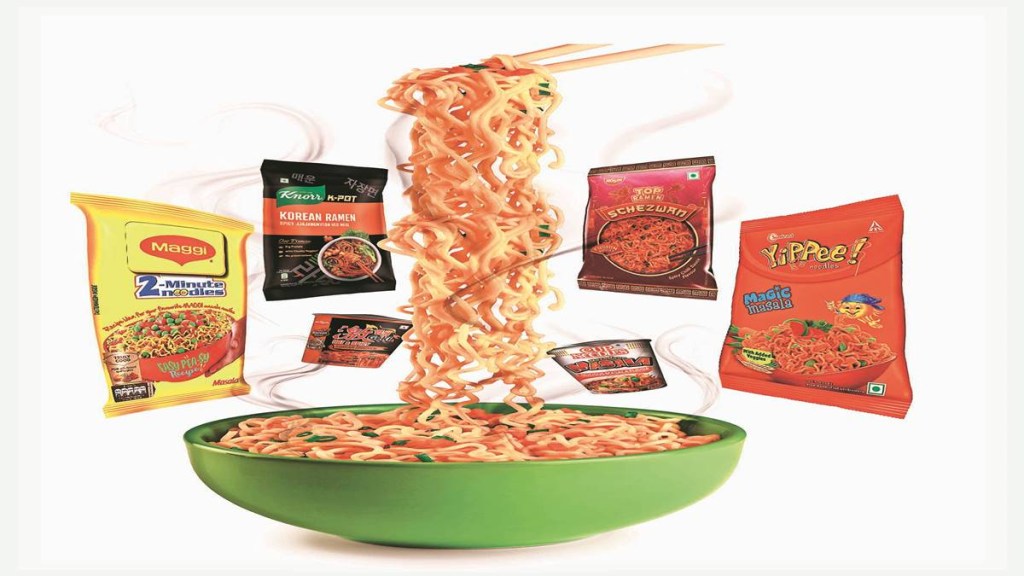Instant noodles and their popularity among Indians are well known. Whether it’s for their unique taste and flavour, convenience of cooking, affordability or accessibility, their widespread acceptance and success remain unmatched among food items. No wonder India emerged as the largest market for Maggi, a popular brand of instant noodles, with a whopping six billion servings sold in FY 2023-24, as per its parent company Nestle India in its annual report. The F&B multinational conglomerate further declared India as one of the fastest-growing markets worldwide.
Maggi remains everywhere, from household kitchens and office canteens to roadside stalls and even cafes and restaurants. No small feat for a brand that entered the Indian market only in 1983—at a time when neither the common Indians were aware of the concept of instant noodles nor packaged food was the norm. However, Nestle India came, created demand where there was none, and the rest is history.
In fact, the instant noodles’ market size in India is expected to grow at an impressive pace—from $1.88 billion in 2023 to $3.83 billion in 2028, at a CAGR of 15.31%, according to market research company Mordor Intelligence. The market is dominated by Nestle’s Maggi followed by ITC’s Sunfeast Yippee!, both of which together control over 80% of the market share. They are followed by Nepal’s CG Foods (Wai Wai), which, essentially an instant noodle maker, has grown tremendously in India and plans for an IPO for its India unit, which it’s eyeing in 2026, as per reports. Other large brands in the space include Hindustan Unilever’s Knorr, Nissin Foods and Patanjali Ayurved.
Incidentally, several newer brands are also coming up, offering fresh flavours and experimenting with unique and healthier ingredients too. “Nissin has been in India for over 30 years, and hence, gained a deep understanding of the Indian consumer,” says Sandeep Bakhshi, managing director of Indo Nissin. Nissin’s India unit entered the country in November 1988 and is widely known for its Top Ramen and cup noodles. “Instant noodles have never been a fragmented category in India, and so we welcome newer competition, as it brings excitement and innovation to the category,” adds Bakhshi.
Such is the competition, especially with newer and local brands coming up, that according to a recent Kantar report, the volume growth of local brands surpassed that of national brands significantly over the one-year period ending April 30.
MasterChow, which sells ready-to-cook Asian meals, entered this highly competitive segment only last year, “Our Chowmein Cup Noodles and Korean 2X Spicy variants have gained significant traction, collectively contributing to about 15% of our overall sales,” says founder Vidur Kataria, who terms the competitive landscape in the instant noodles’ category as “dynamic, with both established players and newer entrants continuously innovating in terms of flavours and ingredients”. However, he adds: “We believe there’s ample room for new companies to enter, grow, and bring fresh ideas to the market.”
Nestle India recently came up with a quirky innovation as it introduced plant-based forks for Maggi cup noodles. Apart from being sustainable, these forks are also edible as they are made with wheat flour.
Despite much room for fresh ideas, the flavour is supreme, companies say. “While health consciousness is a growing trend, particularly in food choices, instant noodles remain an indulgent category focused on taste, convenience, and quick preparation,” says Kataria. “While healthier alternatives are emerging in the market, we believe there’s a significant market segment that values the taste and experience of instant noodles,” he adds.
Concurring the same, Manvendra Shukla, global CEO of CG Foods, the brand behind Wai Wai noodles, says, “From the consumer point-of-view, it is always the taste. Decision-making is heavily skewed towards flavour.”
Masala is king
“The Indian consumer strongly prefers the masala flavour, which accounts for over 90% of the industry,” says Kavita Chaturvedi, COO, Snacks, Noodles and Pasta, Foods Division, ITC. The FMCG behemoth’s offerings include the classic YiPPee! Magic Masala, along with YiPPee! Saucy Masala and YiPPee! Mood Masala.
However, even that is undergoing a change. “For years, instant noodles were only about masala flavour, and it still is 87% of the market (as per NielsenIQ Retail data),” says Varun Oberoi, vice president and head of marketing, Nissin India. “However, it has also seen very low volume growth in the past few years,” he adds.
While flavour is going to be a strong driver for growth, and there will be some base flavours like masala, says CG Foods’ Shukla, the role of unorthodox and local flavours is going to play a very significant role. It’s because the younger generation is more experimental. They want to try new flavours,” he says.
It might only be a slight exaggeration to term Maggi’s 2-minute masala noodles as the face of the instant noodles category itself in India. However, despite the dominance, Nestle India has experimented with flavours, with the kitchens of Asia-inspired Fusian range, and recently tapped into the Korean craze by launching not one but two Korean-flavoured products, for vegetarians and non-vegetarians, respectively.
Besides the standard variants, companies are developing a new range of flavours, such as Chinese, a mix of masalas, etc. This will increase the demand for instant noodles, especially among the children, says the Mordor Intelligence report.
MasterChow entered the segment without a masala offering but “decided to take a different route with unique and distinct flavours like Chowmein and Korean Spicy. While masala flavours saturate the market, our flavours have garnered a cult following and differentiated us in a competitive landscape,” says Kataria.
Innovation is key to growth here, the companies say. “Whatever value growth is happening now is from innovation only; whether it is formats (cup), ingredients (atta, millets), or cuisines (Korean). This will continue for the next 3-4 years,” says Nissin India’s Oberoi.
The K-craze
“Korean is a cultural phenomenon that is trending in India,” says a spokesperson of Hindustan Unilever, which has an instant noodles portfolio under its Knorr brand.
It was during the Covid pandemic that Korean pop culture caught up in the country, and soon the Hallyu came to “disrupt” several segments, including entertainment, beauty, and noodles.
“This is a category disruption,” says CG Foods’ Shukla. “Like the past trendsetters, the Korean wave is already completing three years, and it’s already acquiring some share of the market. It’s still more of an imported product, but you can see an increasing number of domestic brands getting on to this side,” The company launched two new flavours of its Wai Wai noodles earlier this year one of them being Dynamite, a Korean super spicy range, for which “the initial sales have been very encouraging.” Not just Wai Wai, Nestle India, too, unveiled Korean flavoured Maggi noodles last year.
HUL, too, has tapped into this trend with its Knorr K Pot Korean Ramen. “With its international credentials and the promise of ‘restaurant like taste at home’, Knorr offers K Pot Korean Ramen in two exciting flavours—Spicy Kimchi and Spicy Jjajangmyeon,” the spokesperson shares.
While the South Korean food maker Samyang remains dominant internationally, Indo Nissin, which first came up with Top Ramen in the country, enjoys a sizeable market size in this space.
“Geki Hot n Spicy Korean Ramen was launched in 2021 and has been the No.1 Korean noodles brand since then,” claims Indo Nissin’s Oberoi. “As per May’24 NielsenIQ Retail data, Geki has a 47% share of the Korean noodles market that has brands like Maggi Korean, Nongshim, Samyang, Buldak, Knorr Korean and Paldo. This is the fastest growing range in our portfolio for the last three years (growing by 500% every year),” he says, adding that the company is working on its Korean ramen portfolio “by launching new flavours, formats, and SKUs at multiple price points”.
The big and small, traditional and new-age firms are tapping deep into the Korean craze. “The Spicy Korean Cup Noodles was among MasterChow’s initial offerings precisely to tap into the Korean craze, and it has been well-received by our customers. As we continue to innovate, we invite our customers to stay tuned for more exciting products that may be Korean-themed,” Kataria says.
CG Foods’ Shukla continues to term the Korean craze as a “disruptor,” and data, too, hints at the massive rise in the demand. According to the consumer intelligence firm NielsenIQ, the size of the Korean noodles market has grown from `2 crore in 2021 to `65 crore in 2023. “The trend has sustained for a decent amount of time, so we can safely say it’s sort of a disruption,” Shukla says. However, he anticipates a trend. “The Korean noodles might go the Indo-Chinese way. So the look and feel will be Korean but flavours more attuned with the Indian palate,” he says.
Health in focus
While flavours are supreme, companies also experiment with ingredients, especially incorporating healthier alternatives for the increasingly health-conscious populace. For example, Maggi has atta and oats alternatives. ITC has millet and atta noodles. Indo Nissin, too, has an atta option for its Top Ramen noodles.
CG Foods, too, has a product in the pipeline. With 2023 being the Year of Millets, “A lot of brands came out with millet noodles. We, too, have plans sometime in the future. We are in the process of R&D,” says Shukla. “We have also launched noodles with millets last year, keeping in line with consumer trend and government push on millet-based food products,” says Chaturvedi of ITC. “In addition to the newly launched millet noodles, we have our Power Up Atta Noodles, which is made from Aashirvaad Atta,” she adds.
According to the Mordor Intelligence report, “Over the medium term, the market is driven by the players coming up with a new segment of healthier noodles as the consumers in India have become more health conscious. Also, this has opened an opportunity for the players to tap into the innovation part of making instant noodles with functional benefits.”
“Moreover, instant noodles made from white flour were considered unhealthy, and players are coming up with noodles made from atta,” it adds.
While health can be an enabler for companies, it can also be a major restraint.
A case in point was the 2015 Maggi controversy when the noodles faced a five-month ban over allegations that they contained lead beyond the permissible limits. The investigation revealed that it had 17.2 parts per million (ppm) of lead, which is 1,000 times more than the permissible limit of 2.5 ppm.
From having controlled 80% of the market share, its sales dropped to zero, and it’s still to regain its lost ground, especially with more competitors entering the fray, reports say.








